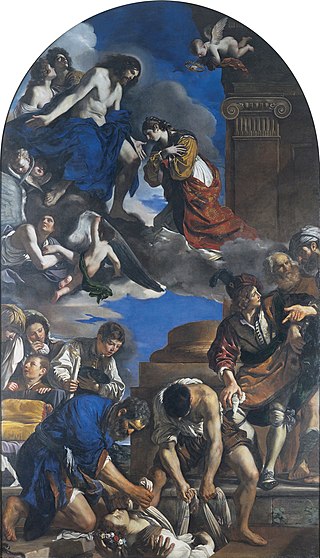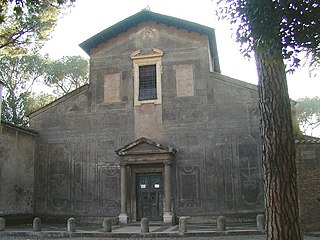Pope John I was the bishop of Rome from 13 August 523 to his death. He was a native of Siena, in Italy. He was sent on a diplomatic mission to Constantinople by the Ostrogoth King Theoderic to negotiate better treatment for Arians. Although John was relatively successful, upon his return to Ravenna, Theoderic had him imprisoned for allegedly conspiring with Constantinople. The frail pope died of neglect and ill-treatment.
Achilles is the name of a Greek mythological hero of the Trojan War.

The Burial of St. Petronilla is an altarpiece painted by the Italian artist Giovanni Francesco Barbieri (Guercino) around 1623. It simultaneously depicts the burial and the welcoming to heaven of the martyred Saint Petronilla. The altarpiece was painted for St. Peter's Basilica in Rome, for a chapel dedicated to the saint and containing her relics. It was later transferred to the Quirinal Palace, before being taken to Paris by Napoleon's troops. Brought back to Italy by Antonio Canova, it was placed in the Capitoline Museums of Rome in 1818, where it is currently displayed.

Pancras was a Roman citizen who converted to Christianity and was beheaded for his faith at the age of fourteen, around the year 304. His name is Greek (Πανκράτιος) and means "the one that holds everything".

May 11 - Eastern Orthodox Church calendar - May 13

May 30 - Eastern Orthodox Church calendar - June 1

Saint Anastasia is a Christian saint and martyr who died at Sirmium in the Roman province of Pannonia Secunda. In the Eastern Orthodox Church, she is venerated as St. Anastasia the Pharmakolytria, i.e. "Deliverer from Potions". This epithet is also translated as "One who Cures (Wounds)" in Lampe's A Patristic Greek Lexicon.

Santi Nereo ed Achilleo is a fourth-century basilica church in Rome, Italy, located in via delle Terme di Caracalla in the rione Celio facing the main entrance to the Baths of Caracalla. It has been the titular church of Cardinal Celestino Aós Braco since 28 November 2020.

Saint Crispina was a virgin martyr of Africa who suffered during the Diocletian persecution. She was born at Thagara, a town in the Roman province of Numidia, located in Taoura, Algeria. in North Africa.) She died by beheading at Theveste, in Numidia.
Saint Nicomedes was a Martyr of unknown era, whose feast is observed 15 September. He was buried in a catacomb on the Via Nomentana near the gate of that name.

Nereus and Achilleus are two Roman martyr saints. In the present General Roman Calendar, revised in 1969, Nereus and Achilleus (together) are celebrated on 12 May.
Flavia Domitilla was a Roman noblewoman of the 1st century. She was a granddaughter of Emperor Vespasian and a niece of Emperors Titus and Domitian. She married her cousin, the consul Titus Flavius Clemens, a grand-nephew of Vespasian through his father Titus Flavius Sabinus.

Petronilla is an early Christian saint. She is venerated as a virgin by the Catholic Church. She died in Rome at the end of the 1st century, or possibly in the 3rd century.

Felicitas of Rome, also anglicized as Felicity, is a saint numbered among the Christian martyrs. Apart from her name, the only thing known for certain about this martyr is that she was buried in the Cemetery of Maximus, on the Via Salaria on a 23 November. However, a legend presents her as the mother of the seven martyrs whose feast is celebrated on 10 July. The Eastern Orthodox Church celebrates their martyrdom on 25 January.
The Tridentine calendar is the calendar of saints to be honoured in the course of the liturgical year in the official liturgy of the Roman Rite as reformed by Pope Pius V, implementing a decision of the Council of Trent, which entrusted the task to the Pope.
Marcellus and Apuleius were third- or fourth-century martyrs who were inserted in the General Roman Calendar in the 13th century. They were recognized as saints by the Catholic Church, with 7 October as their feast day. Apuleius is considered purely legendary, and is no longer recognized.
Saint Achilles may refer to:

The title Virgin is an honorific bestowed on female saints and blesseds in some Christian traditions, including the Eastern Orthodox Church and the Catholic Church.

The Enemy is a post-apocalyptic young adult horror novel written by Charlie Higson. The book takes place in London, United Kingdom, after a worldwide sickness has infected adults, turning them into something akin to voracious, cannibalistic zombies. Puffin Books released The Enemy in the UK on 3 September 2009, Disney Hyperion in the US on 11 May 2010.
Auspicius of Apt also known as Auspice of Apt (96–102), was a Pre-Congregational saint, first bishop of Apt, France who was consecrated by Clement I and martyred under Trajan.
This page is based on this
Wikipedia article Text is available under the
CC BY-SA 4.0 license; additional terms may apply.
Images, videos and audio are available under their respective licenses.










